How to make a sourdough starter (day 1 to day 7) is part of Sourdough Starter 101 course.
We talked about what do you need to start your culture and I gave you all the tips I have to feed your sourdough starter. Now we're finally putting everything to practice!
Don't worry, I'm breaking it down day by day for you, with photos, feeding suggestions, and a briefly resume of what you should expect.
Let's start our sourdough culture!
Day 1 | Day 2 | Day 3 | Day 4 | Day 5 | Day 6 | Day 7
When did my starter had enough activity to be used for baking?
DAY 1
- A. Rye flour + whole wheat or bread flour: add ⅓ cup (or 50g) rye flour + ⅓ cup (or 50g) whole wheat or bread flour + ½ cup (or 100g) water.
- B. Unbleached all-purpose flour: ⅔ cup (or 100g) all-purpose flour + ½ cup (or 100g) water.
Clean your jar. Mix water and flour and stir until there are no clumps nor dry bits of flour present.
Close the jar with a tablecloth and use a rubber band to keep it there. You can also use its lid, just make sure you’re only resting it on the top of your container, not closing it completely.
Keep your culture in a warm spot for 24 hours. If you can control the temperature, keep it between 70°F and 80°F (21°C to 27°C) (this applies for all days).
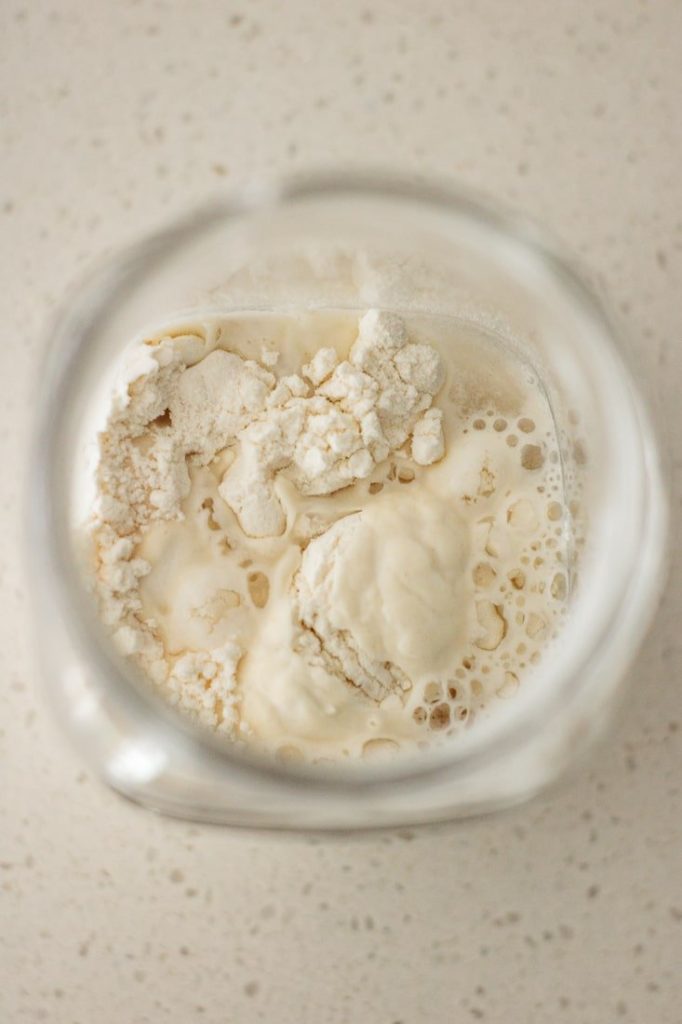
The sourdough culture you can see in the photos is made entirely with unbleached AP flour.
DAY 2
- A. Rye flour + whole wheat or bread flour: add ⅓ cup (or 50g) rye flour + ⅓ cup (or 50g) whole wheat or bread flour + ½ cup (or 100g) water.
- B. Unbleached all-purpose flour: ⅔ cup (or 100g) all-purpose flour + ½ cup (or 100g) water.
On day 2, you may or may not see some fermentation activity in your culture. If there’s activity, it should be tiny.
Discard half of your culture, then add water and flour, and stir with a spoon or spatula until homogeneous. Cover and let it rest for another 24 hours in a warm spot.
Mine had no visible activity on day 2. It smelled like wet all-purpose flour and had a tiny amount of liquid on top.
But remember: every starter is different. Don’t go all crazy if your starter doesn’t look exactly like the one in the photos.

DAY 3
- A. Rye flour + whole wheat or bread flour: add ⅓ cup (or 50g) rye flour + ⅓ cup (or 50g) whole wheat or bread flour + ½ cup (or 100g) water.
- B. Unbleached all-purpose flour: ⅔ cup (or 100g) all-purpose flour + ½ cup (or 100g) water.
On day 3, some activity may be present. Discard, feed, stir and wait. Starting from now on you’ll do it twice a day to keep that activity going faster.
How do you know if your starter is active? If the culture is thriving, it will have small and wispy bubbles that resemble soap bubbles on the top. If yours is a bit slower, you’ll see smaller, pinhole-like bubbles.
I usually feed my starter by morning and late afternoon, but do it anytime that works for you. Just try to keep it around 12 hours apart: if you feed your starter at 8 AM, feed it again between 6 and 10 PM.
One thing that can happen on day 3: your starter may have shown crazy activity on day 2, but this activity may have died off (or it will on day 4), and you may think your starter is dead. IT IS NOT.
If you’re wondering if there’s something wrong, go to the troubleshooting section.
My starter was more active on day 3. It was a bit more bubbly, and it smelled sweet with just a hint of vinegar.

DAY 4
- A. Rye flour + whole wheat or bread flour: add ⅓ cup (or 50g) rye flour + ⅓ cup (or 50g) whole wheat or bread flour + ½ cup (or 100g) water.
- B. Unbleached all-purpose flour: ⅔ cup (or 100g) all-purpose flour + ½ cup (or 100g) water.
If your starter is in a warmer environment and you’re feeding it right, day 4 will be the day you’ll see signs of activity – if you haven’t already on the last two days.
There will be lots of bubbles, both on top of your sourdough starter as well some visible on the sides. Your starter may have risen and fallen a bit, and you can see it by streaks on the sides of your jar.
Don’t give up if there’s no sign of activity: try placing your starter in a warmer environment.

Mine was a bit more liquid than on day 3. There were lots of bubbles (the soap-like ones) on the top, and it had a strong alcohol smell (it was underfed, I forgot to feed it in the morning - ops).
It also has a bit of hooch (another sign it needs food), the light brown liquid you can see in the photo. I fed it 4PM and 11PM – not the ideal space between feeds, but better than nothing.
DAY 5
- A. Rye flour + whole wheat or bread flour: add ⅓ cup (or 50g) rye flour + ⅓ cup (or 50g) whole wheat or bread flour + ½ cup (or 100g) water.
- B. Unbleached all-purpose flour: ⅔ cup (or 100g) all-purpose flour + ½ cup (or 100g) water.
Fermentation activity should be present and increase with each passing day now. Your starter probably won’t bubble twice its size, but if it did, congratulations, it’s almost ready to be used for baking!
Mine was less liquid today. The alcohol smell was also less strong, and the sour smell more prominent. Lots of bubbles on the top and on its sides, but no rising activity yet.
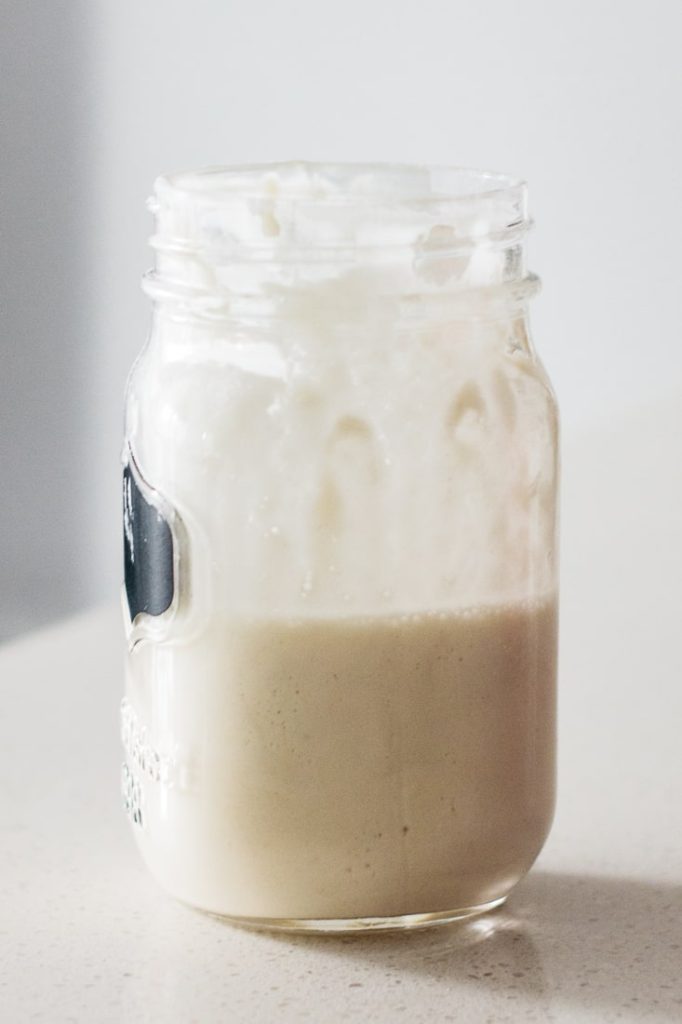
DAY 6
- A. Rye flour + whole wheat or bread flour: add ⅓ cup (or 50g) rye flour + ⅓ cup (or 50g) whole wheat or bread flour + ½ cup (or 100g) water.
- B. Unbleached all-purpose flour: ⅔ cup (or 100g) all-purpose flour + ½ cup (or 100g) water.
Fermentation activity should be present and increase with each passing day. Your starter may or may not rise twice its size.

Mine has a lot of small bubbles on top and sides, the sour smell was pleasant and the alcohol smell was almost gone.
DAY 7
- A. Rye flour + whole wheat or bread flour: add ⅓ cup (or 50g) rye flour + ⅓ cup (or 50g) whole wheat or bread flour + ½ cup (or 100g) water.
- B. Unbleached all-purpose flour: ⅔ cup (or 100g) all-purpose flour + ½ cup (or 100g) water.
On day 7, you should already be able to see the rise and fall of your dough.
But if you still can’t, don’t give up! It’s totally normal. My first starter, made with rye and bread flour, took 8 days to show this much activity.
It depends on a lot of factors for your starter to show good activity on day 7:
- Quality of ingredients: Is your flour good? Organic? The water you’re using is free of chemicals?
- Temperature: Is your starter in a warm enough spot? Is your kitchen too cold? Did the temperature drop too much too suddenly?
- Feeding: Have you remembered to clean your jar before starting? Are you feeding it twice a day? Or at least one? Is the time between the feedings appropriate (10 to 12 hours apart)?
On day 7, my unbleached AP flour starter was showing less activity than my rye and bread flour starter. If yours is the same, keep feeding it twice a day for another couple of days. You may even need to keep it for another week.
Try moving it to a warmer spot, if you’re in the middle of Winter and/or where you live is super cold, put your starter inside an empty shoe box and in direct sunlight. You can find more tips for keeping it warm here.

When did my AP sourdough starter had enough activity to be used for baking?
On day 12, my culture was ready, and baked a fair loaf of sourdough white bread. Day 12 was the first day it doubles its size and also passed the float test.
So, if your starter is not ready like mine wasn’t on day 7, be patient! Don’t give up: discard, feed, stir and wait.
Repeat this like a mantra.
Next: Taking care of your sourdough starter
Or go back to Sourdough Starter 101
FOLLOW ME on INSTAGRAM, PINTEREST, FACEBOOK, and YOUTUBE for more sourdough recipes that work!

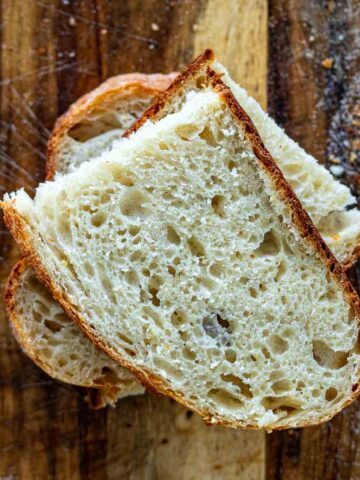
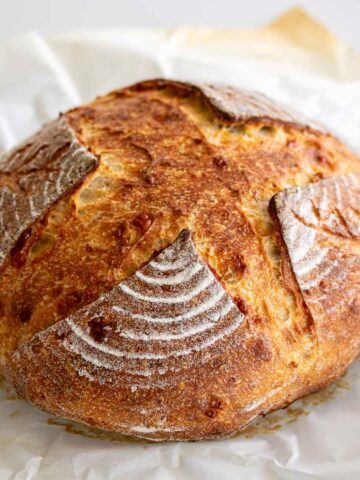
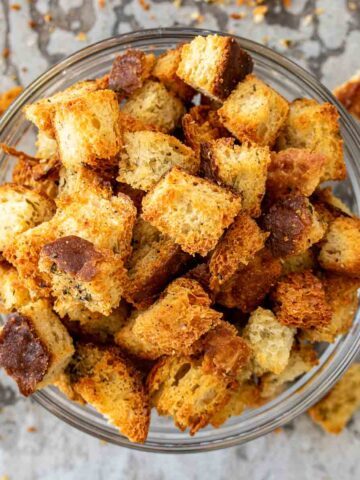
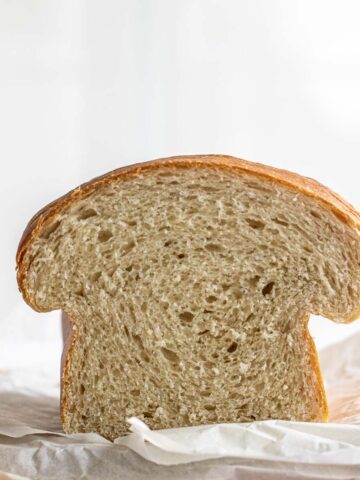
Leave a Reply